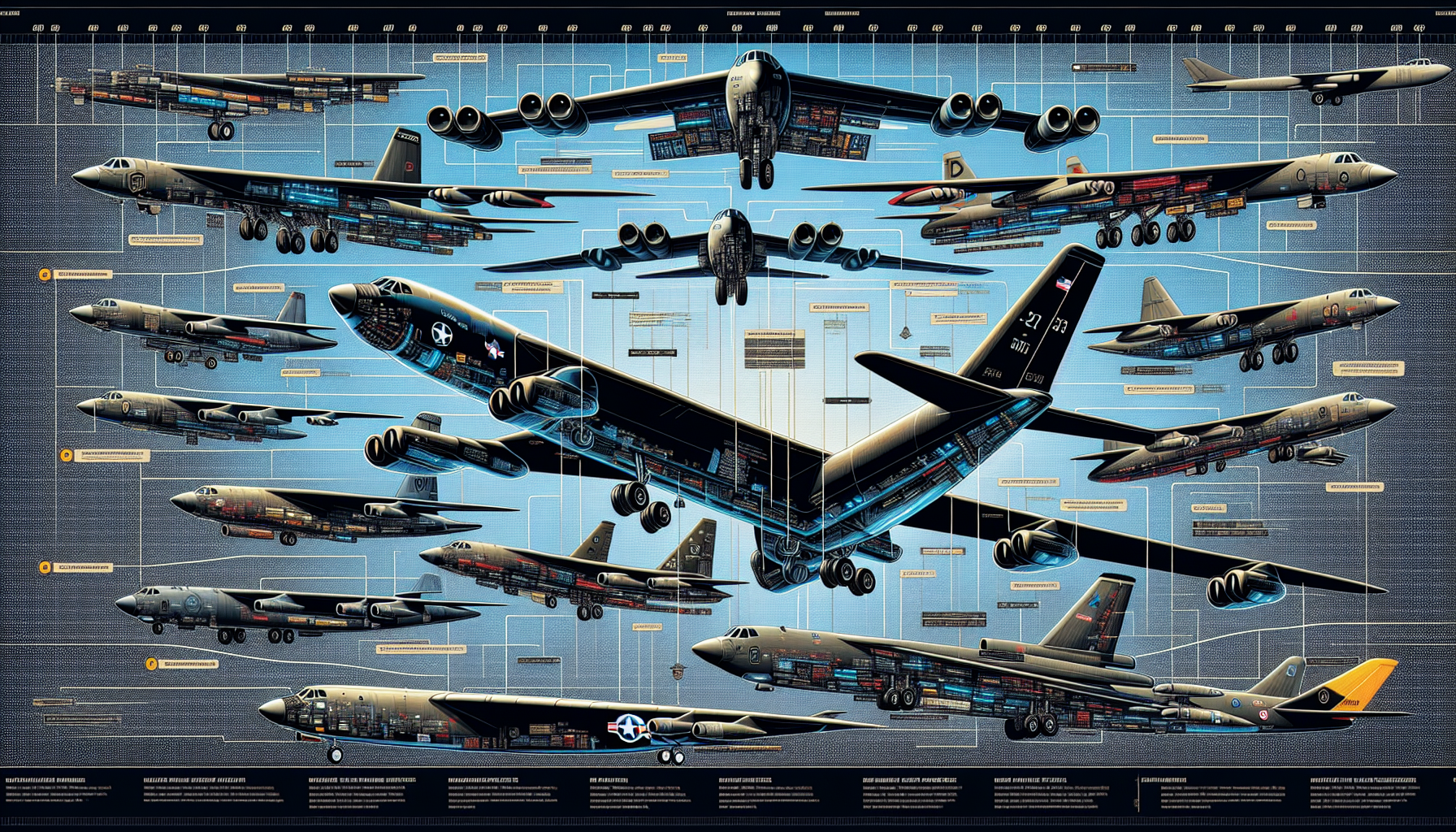B-52 Bomber: Legacy and Modern Powerhouse of the U.S. Air Force
The B-52 Bomber, or B-52 Stratofortress, has been a cornerstone of the U.S. Air Force since the 1950s. Known for its long range and massive payload, the B-52 remains a key player in modern warfare. This article covers its history, design, and future.
Key Takeaways
-
The B-52 Stratofortress, first introduced in 1954, has undergone multiple iterations, with the B-52H variant currently projected to remain operational until 2050 due to its adaptability and modernization efforts.
-
The aircraft is distinguished by its extensive capabilities, including the ability to deliver both nuclear and conventional payloads, execute diverse missions, and utilize advanced targeting and electronic warfare systems.
-
Ongoing modernization efforts, such as engine replacements and updated radar systems, are essential for maintaining the B-52’s strategic relevance and operational effectiveness in future military conflicts.
Evolution of the B-52 Bomber

The B-52 Stratofortress first flew in 1954 with the B-52A model, heralding a new era in aerial warfare. By 1955, the B-52B entered service, swiftly becoming the primary long-range bomber for the U.S. Air Force. Over the next several years, the B-52 underwent numerous iterations, with a total of 744 aircraft manufactured by the time the final B-52H model was delivered in October 1962.
The B-52H variant, first delivered to the Strategic Air Command in May 1961, represented the pinnacle of this series’ development. This model incorporated advanced technologies and design improvements that enhanced its performance and operational capabilities. The B-52H Stratofortress remains in service to this day, a testament to its robust design and adaptability.
For over six decades, the B-52 has been a critical component of the U.S. Air Force’s manned strategic bomber force. Its versatility and reliability have made it indispensable in various military operations, from strategic bombing missions to close air support and maritime operations. The aircraft’s longevity is further underscored by its projected operational life until 2050, ensuring its continued relevance in future conflicts.
Over its storied history, the B-52 has participated in numerous conflicts and missions, repeatedly demonstrating its strategic value. As we look to the future, the B-52’s enduring legacy and ongoing modernization efforts promise to keep this iconic aircraft at the forefront of aerial warfare for many years to come.
B-52 Stratofortress Design and Features

Renowned for its distinctive design and impressive capabilities, the B-52 Stratofortress stands out. One of the most striking features of the B-52 is its eight-engine configuration. These engines are arranged in four pods beneath the wings, a design that not only provides the necessary thrust but also helps delay stall onset, contributing to the aircraft’s stability and performance.
The wings are another marvel of engineering. With a wingspan of 185 feet, these flexible wings can bend during flight, reducing stress on the airframe and ensuring a smoother ride. The cockpit, originally designed with tandem seating, was later redesigned to a side-by-side layout to enhance crew efficiency and coordination.
The control systems are equally sophisticated. The aircraft uses a system of six spoilerons on each wing for roll control, compensating for the lack of traditional ailerons. Additionally, the main landing gear can pivot up to 20 degrees, significantly improving crosswind landing capabilities. These design features collectively contribute to the B-52’s operational flexibility and effectiveness.
Overall, the B-52 Stratofortress is not just a bomber; it is a long-range, subsonic, jet-powered strategic bomber with capabilities that have stood the test of time. Its design allows it to carry a variety of payloads, including gravity bombs, conventional cruise missiles, and precision-guided missiles, making it a versatile asset in the Air Force Global Strike Command.
Operational History and Key Missions
Since its introduction, the B-52 has been a vital asset in U.S. military operations, showcasing its importance in national defense. Its operational history is filled with numerous combat missions that highlight its versatility and strategic value. The demand for B-52 airpower often exceeds its operational capacity, underscoring the aircraft’s critical role in various military operations.
From the Cold War to modern conflicts, the B-52 has consistently proven its worth. Adaptability in missions ranging from strategic attacks to maritime operations makes it an irreplaceable asset in the U.S. Air Force’s arsenal.
Early Service and Cold War Era
During its early service, the B-52 demonstrated remarkable flexibility, excelling in various roles such as strategic attack and maritime operations. Its capability to cover vast ocean areas was particularly notable; a pair of B-52s could effectively survey up to 140,000 square miles of ocean within just two hours. This impressive range and surveillance capability made the B-52 a formidable presence during the Cold War, contributing to its reputation as a key strategic asset.
The Cold War era saw the B-52 primarily serving as a deterrent against conventional conflict, leveraging its long-range capabilities and nuclear payload potential to maintain peace through strength. The aircraft’s ability to quickly adapt to different mission profiles further solidified its role in the U.S. military strategy during this tense period.
Vietnam War and Beyond
The Vietnam War marked a significant chapter in the B-52’s operational history. Initially designed for nuclear delivery, the B-52’s first combat mission involved conventional bombing in South Vietnam in 1965. This shift highlighted the aircraft’s versatility and adaptability in different combat scenarios. The B-52 was extensively used for carpet bombing missions, which had a profound impact on the conflict.
Notable operations during the Vietnam War included Operation Arc Light and Operation Linebacker II, where B-52s targeted enemy positions across Southeast Asia. By the end of the war, B-52s had completed over 126,000 sorties, demonstrating their critical role in the air campaign. The aircraft’s ability to deliver a significant portion of the coalition’s aerial ordnance in Operation Desert Storm further showcased its enduring combat effectiveness.
Beyond Vietnam, the B-52 continued to adapt to new roles and missions, participating in various conflicts and demonstrating its strategic value. Its ability to deliver both nuclear and conventional payloads made it a versatile tool in the U.S. Air Force’s arsenal.
Modern Deployments
In the years following its Cold War service, the B-52 played a vital role in modern conflicts, including Operation Desert Storm and operation desert strike, where it delivered 40% of all coalition weapons dropped. This significant contribution underscored the B-52’s ability to adapt to contemporary warfare and deliver precision-guided munitions with remarkable accuracy.
The aircraft’s role continued to evolve in subsequent operations. During Operation Enduring Freedom, the B-52 provided continuous support with precision-guided munitions, showcasing its enhanced targeting capabilities and modern technology. The B-52 returned to combat in 2016, conducting missions against ISIS in Syria and Iraq, further demonstrating its adaptability and relevance in modern warfare.
Continued involvement in significant military operations highlights the B-52’s enduring value as a strategic asset. Its ability to deliver a wide range of munitions and perform various mission types ensures its ongoing importance in the U.S. Air Force’s strategic planning.
Weapons Payload and Capabilities

The B-52 Stratofortress is renowned for its extensive weapons payload and capabilities. Designed to carry a diverse array of weapons, the B-52 can deliver both nuclear and conventional payloads, making it a versatile asset in the Air Force inventory. The aircraft’s ability to carry gravity bombs, cluster bombs, and precision-guided missiles ensures its effectiveness in various combat scenarios.
One of the B-52H Stratofortress’s most significant capabilities is its ability to launch up to 20 air-launched cruise missiles, enhancing its strike capabilities. This feature allows the B-52 to engage ground targets from a safe distance, reducing the risk to the aircraft and its crew. The B-52’s ability to carry precision-guided munitions, including joint direct attack munitions and laser-guided bombs, further enhances its combat effectiveness.
The B-52’s adaptability extends to its ability to perform strategic strikes, close air support, and maritime operations. Its diverse payload options, including gravity bombs and precision-guided conventional ordnance, make it a formidable presence on the battlefield. The aircraft’s capability to carry out standoff attacks with precision-guided munitions ensures it remains a vital tool in the U.S. Air Force’s strategic arsenal.
Overall, the B-52’sweapons payload and capabilities underscore its versatility and strategic value. Whether delivering nuclear payloads or precision-guided conventional ordnance, the B-52 remains a critical component of the U.S. military’s combat effectiveness.
Advanced Systems and Upgrades
The B-52 has undergone numerous upgrades to enhance its systems and capabilities, maintaining its operational relevance. Upgrades include advanced radios for improved communication, especially with Navy vessels, ensuring the B-52 remains formidable in modern warfare. The modernization efforts are designed to meet current and future operational requirements, ensuring the B-52 can continue to perform its vital roles effectively.
Ongoing upgrades include significant enhancements in avionics, targeting, and communication systems. These improvements are essential for maintaining the aircraft’s combat effectiveness and operational flexibility in various mission scenarios. The integration of modern technology ensures the B-52 remains a critical asset in the U.S. Air Force’s strategic planning.
Electronic Warfare Systems
Electronic warfare capabilities have been continuously upgraded to keep pace with evolving threats. The ALQ-172 system, a cornerstone of the B-52’s electronic warfare suite, has been enhanced to include advanced counter-measures and geolocation situational awareness. These upgrades ensure the B-52 can effectively detect and counter threats, maintaining its operational effectiveness in contested environments.
The upcoming ALQ-172 MARS upgrade aims to further improve the system’s capabilities while reducing weight and power demands. This upgrade will enhance the maintainability and effectiveness of the B-52’s electronic warfare systems, ensuring the aircraft can continue to operate in modern threat environments.
Avionics and Targeting Enhancements
Significant advancements in avionics and targeting systems ensure the B-52 remains a potent force in modern warfare. The offensive avionics system has been modernized to improve targeting accuracy and engage advanced threats. This includes integrating advanced targeting pods such as the Sniper and LITENING pods, which provide enhanced targeting capabilities and night vision.
Future upgrades will equip the B-52J with an advanced active electronically scanned array radar, significantly improving navigation, targeting, and self-defense capabilities. These upgrades are essential for maintaining the B-52’s effectiveness in various combat scenarios, allowing it to engage ground targets with precision-guided munitions and air-launched cruise missiles.
The integration of modern radar and electronic warfare systems further enhances the B-52’s threat detection and countermeasure capabilities. These advancements ensure the aircraft can operate effectively in contested environments, maintaining its role as a critical asset in the U.S. Air Force’s strategic arsenal.
Communications and Navigation
Communications and navigation systems have also undergone significant upgrades, ensuring the B-52 remains effective in modern combat operations. The Combat Network Communications Technology (CONECT) system provides real-time data sharing and improved situational awareness, enhancing the B-52’s operational capabilities. This system enables seamless communication between the B-52 and other aircraft, as well as ground and naval forces, ensuring coordinated and effective mission execution.
The worldwide precision navigation capability of the B-52 ensures it can operate effectively in various theaters, providing reliable positioning and targeting. These advanced communications and navigation systems significantly enhance the B-52’s role in modern warfare, ensuring it remains a critical asset in the U.S. Air Force’s strategic planning.
Power Plant and Performance
The B-52H Stratofortress is powered by eight Pratt & Whitney TF33-P-3 turbofan engines, each producing more than 17,000 pounds of thrust. This impressive power plant allows the B-52H to achieve a maximum speed of 1,000 km/h and a service ceiling of 15,151 meters. Reaching high subsonic speeds and altitudes, the aircraft maintains a formidable presence in the skies.
The B-52H features a fuel capacity exceeding 181,000 liters, allowing for an unrefueled operational range surpassing 8,600 miles. This extensive range ensures the B-52 can conduct long-range missions without the need for aerial refueling, enhancing its strategic value. The aircraft’s operational range of approximately 15,937 kilometers further underscores its ability to perform a wide variety of missions across vast distances.
With a typical combat radius of approximately 8,800 miles, the B-52 can effectively engage targets far from its base of operations. This capability, combined with its significant payload and advanced systems, ensures the B-52 remains a critical asset in the U.S. Air Force’s strategic bomber force.
Strategic Roles and Versatility

Renowned for its versatility, the B-52 Stratofortress can carry out multiple missions, including strategic attacks, close air support, air interdiction, and maritime operations. This flexibility makes the B-52 an indispensable asset in the U.S. Air Force’s strategic and tactical planning.
In a conventional conflict, the B-52 performs strategic attacks, offensive counter-air missions, and provides close air support, demonstrating its adaptability and effectiveness in a combat mission involving its ability to deliver precision-guided munitions and standoff weapons, ensuring its ongoing relevance in modern warfare.
Strategic Attack and Air Interdiction
The B-52 has played a significant role in strategic attacks and air interdiction missions throughout its operational history. During major conflicts like Operation Desert Storm and Iraqi Freedom, the B-52 demonstrated its ability to deliver precision-guided munitions with remarkable accuracy. This capability has been further enhanced by modern targeting systems and advanced avionics, ensuring the B-52 remains effective in contemporary combat scenarios.
In recent years, the B-52 has adapted to new roles, including offensive counter-air missions and close air support. Its ability to deliver joint direct attack munitions and other precision-guided munitions has enhanced its effectiveness in these roles. The aircraft’s participation in operations like Desert Strike and Enduring Freedom highlights its versatility and strategic value.
Performing strategic attacks and air interdiction missions, the B-52 remains a critical component of the U.S. Air Force’s manned strategic bomber force. Its advanced targeting pods and precision-guided missiles ensure it can engage a wide range of targets with precision and effectiveness.
Close Air Support and Maritime Operations
The B-52 excels in close air support and maritime operations. Its ability to provide firepower and flexibility in various combat scenarios makes it an invaluable asset for supporting ground forces and naval operations. The B-52’s advanced targeting pods and precision-guided munitions ensure it can deliver accurate and effective support in these roles.
In addition to close air support, the B-52 plays a significant role in maritime operations, including ocean surveillance and mine-laying activities. Its capability to cover vast ocean areas and assist in anti-ship operations underscores its strategic value in naval scenarios.
Overall, the B-52 enhances U.S. military operations with its versatile capabilities in close air support and maritime missions. Its ability to adapt to different mission profiles ensures it remains a critical component of the U.S. Air Force’s strategic planning.
Future Prospects and Sustainment
The B-52 is undergoing a comprehensive modernization program estimated at $48.6 billion to extend its operational lifespan until around 2060. These upgrades include new engines and radar systems, which are set to begin in the late 2020s. The new engines are designed to improve maintenance efficiency, allowing for longer operational periods between servicing.
Upcoming communications upgrades will enhance connectivity and information flow for B-52 crews, improving operational capabilities. These enhancements ensure the B-52 remains effective in modern combat scenarios, maintaining its relevance in strategic planning.
Despite delays and cost overruns, modernization efforts are crucial for the B-52’s future prospects. The integration of new technologies and systems will ensure the B-52 remains a formidable presence in the skies, capable of performing a wide range of missions with enhanced combat effectiveness.
Aircraft on Display

The legacy of the B-52 Stratofortress is preserved in various museums and air force bases across the U.S. One notable example is the B-52B on display at Wings Over the Rockies, which was the seventh B-52 constructed and initially built for reconnaissance purposes before being converted into a bomber. This aircraft served during the Cuban Missile Crisis and later played a role in training munitions loading at Lowry Air Force Base.
The B-52B at Wings Over the Rockies is on loan from the National Museum of the US Air Force, highlighting the historical significance of these aircraft. Several other B-52s are on display in various locations, serving as a testament to the aircraft’s enduring legacy and its critical role in U.S. military history.
Contracts and Collaborations
Modernization efforts involve key collaborations between the USAF and defense contractors like Boeing, particularly in the development of the Boeing military airplane. One major contract involves the replacement of the Pratt & Whitney TF33 engines with Rolls-Royce F130 engines, with Boeing overseeing the integration. This engine replacement is crucial for improving the B-52’s operational efficiency and extending its service life.
Another significant collaboration is the radar modernization program, which aims to replace the outdated APQ-166 radar with the Raytheon APG-79 Bomber Modernized Radar System. These collaborations and contracts are vital for maintaining the B-52’s relevance and effectiveness in modern warfare, ensuring it remains a critical asset in the U.S. Air Force’s arsenal.
Summary
The B-52 Bomber’s legacy as a cornerstone of the U.S. Air Force is undeniable. From its early days during the Cold War to its critical role in modern conflicts, the B-52 has demonstrated its unmatched capabilities and strategic importance. Its unique design, extensive weapons payload, and advanced systems have ensured its continued relevance in various combat scenarios.
As the B-52 undergoes comprehensive modernization, it is set to remain operational until around 2060, ensuring its strategic value for decades to come. The ongoing upgrades and collaborations will keep the B-52 at the forefront of aerial warfare, maintaining its critical role in the U.S. Air Force’s strategic planning and operations.
Frequently Asked Questions
When was the B-52 Stratofortress first introduced into service?
The B-52 Stratofortress was first introduced into service with the U.S. Air Force in 1955.
What is the maximum operational range of the B-52H without aerial refueling?
The B-52H has a maximum operational range of approximately 8,600 miles without aerial refueling. This remarkable range enhances its strategic capabilities significantly.
What types of weapons can the B-52 carry?
The B-52 is capable of carrying a variety of weapons, such as gravity bombs, cluster bombs, precision-guided missiles, and air-launched cruise missiles. This versatility enhances its effectiveness in various combat scenarios.
How has the B-52's role evolved over the years?
The B-52 has transformed from a nuclear delivery aircraft to a versatile platform engaged in strategic strikes, close air support, and maritime operations. This evolution reflects its adaptability to diverse military needs over the years.
What modernization efforts are being undertaken for the B-52?
The B-52 is receiving significant modernization efforts, featuring new engines, upgraded radar systems, and enhancements in communication and targeting capabilities. These improvements aim to extend its operational lifespan and effectiveness.







